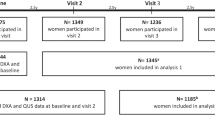Abstract:
The possibility of using quantitative ultrasound (QUS) in monitoring the response to antiresorptive drugs has yet to be defined. The aim of the present study was to evaluate whether heel ultrasonography, considering its characteristics of long-term precision, is able to monitor osteoporotic patients treated with alendronate. We studied 150 postmenopausal osteoporotic women (age 59.6 ± 5.3 years) treated with alendronate and calcium (n= 74) or with calcium alone (n= 76) for 4 years. At baseline and after 12, 24, 36 and 48 months, we measured bone mineral density (BMD) at the lumbar spine by dual-energy X-ray absorptiometry (DXA, Hologic 4500), and speed of sound (SOS), broadband ultrasound attenuation (BUA) and Stiffness at the calcaneus by Achilles plus. Moreover, the longitudinal precision of QUS parameters was assessed by measuring 10 subjects once a month for 1 year and, on the basis of the coefficients of variation we obtained, we calculated the Least Significant Change between two measurements. In the alendronate-treated patients, at year 1, BMD increased by 4.2%, SOS by 0.4%, BUA by 1.1% and Stiffness by 3.2%; at year 2, BMD increased by 5.0%, SOS by 0.7%, BUA by 1.4% and Stiffness by 5.7%. At year 3, BMD increased by 6.2%, SOS by 0.9%, BUA by 1.8% and Stiffness by 7.6%. At the end of the study period, BMD increased by 7.6%, SOS by 1.2%, BUA by 1.9% and Stiffness by 9.0%. The minimal significant difference between two measurements was 0.8% for SOS, 5.6% for BUA and 5.0% for Stiffness. Among the QUS parameters, Stiffness showed the greatest total treatment effect and a longitudinal sensitivity which was only slightly lower than BMD. The MTI, which represents the period between scans required to show that a ‘true’ change has occurred, was 1.8, 2.7, 11.9 and 2.2 years for BMD, SOS, BUA and Stiffness respectively. Therefore, although the spinal BMD remains the optimal method, QUS at the heel, and in particular Stiffness, seems to be a sensitive tool for monitoring the response to alendronate.
Similar content being viewed by others
Author information
Authors and Affiliations
Additional information
Received: 30 August 2001 / Accepted: 29 November 2001
Rights and permissions
About this article
Cite this article
Gonnelli, S., Cepollaro, C., Montagnani, A. et al. Heel Ultrasonography in Monitoring Alendronate Therapy: A Four-Year Longitudinal Study . Osteoporos Int 13, 415–421 (2002). https://doi.org/10.1007/s001980200048
Issue Date:
DOI: https://doi.org/10.1007/s001980200048




